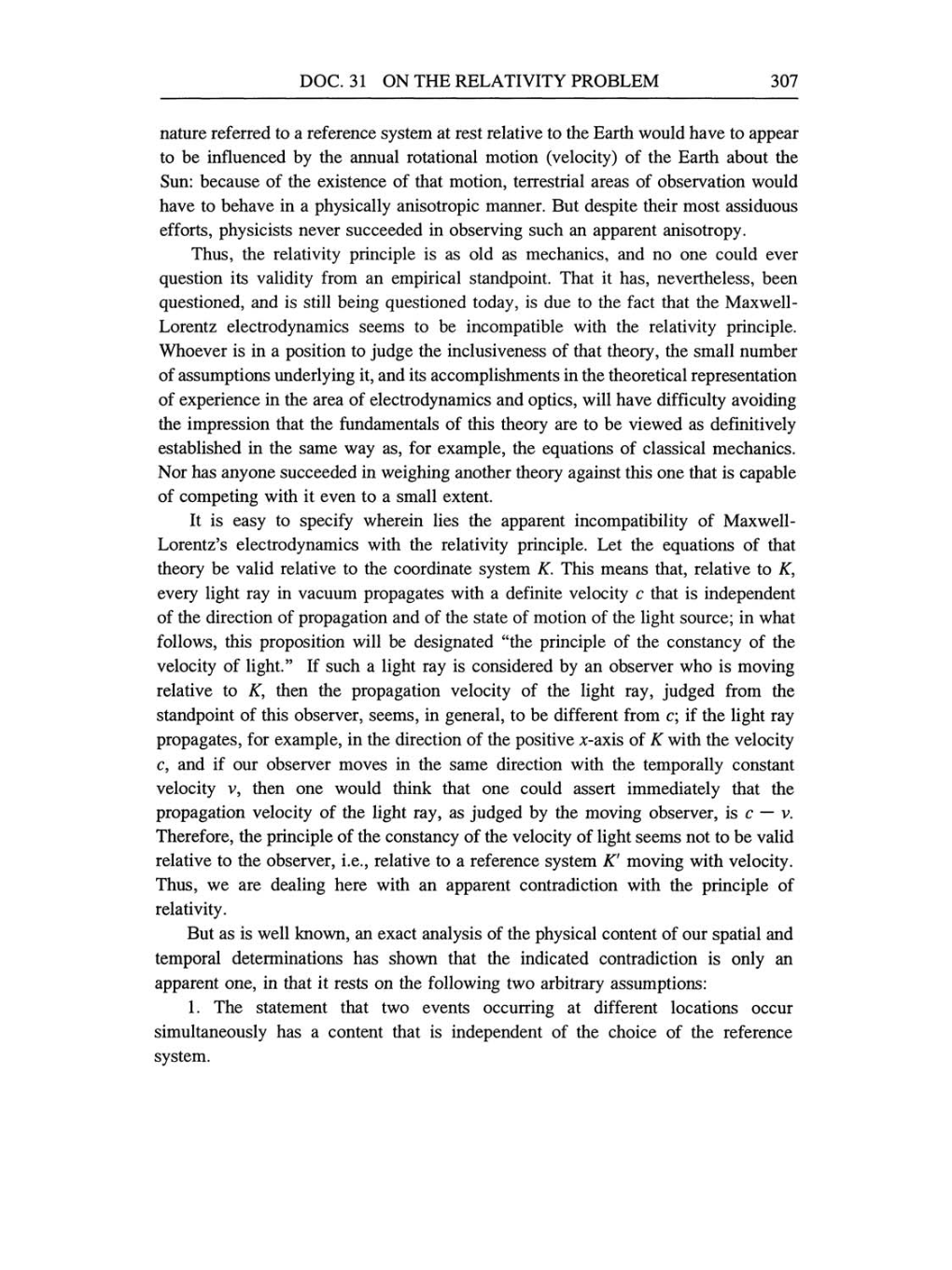DOC.
31
ON THE RELATIVITY PROBLEM
307
nature
referred
to
a
reference
system
at rest
relative
to
the Earth would have
to
appear
to
be influenced
by
the annual rotational motion
(velocity)
of the Earth about the
Sun:
because of the existence
of
that
motion,
terrestrial
areas
of observation would
have
to
behave
in
a
physically anisotropic
manner.
But
despite
their
most
assiduous
efforts,
physicists never
succeeded
in
observing
such
an apparent anisotropy.
Thus,
the
relativity principle
is
as
old
as
mechanics, and
no one
could
ever
question
its
validity
from
an
empirical standpoint.
That
it has, nevertheless,
been
questioned,
and
is
still
being questioned today,
is
due
to
the fact that the Maxwell-
Lorentz
electrodynamics
seems
to be
incompatible
with the
relativity
principle.
Whoever is
in
a
position
to
judge
the inclusiveness of that
theory,
the small number
of
assumptions underlying it,
and
its
accomplishments
in
the theoretical
representation
of
experience
in the
area
of
electrodynamics
and
optics,
will have
difficulty avoiding
the
impression
that the fundamentals of this
theory are
to
be
viewed
as
definitively
established
in
the
same
way as,
for
example,
the
equations
of classical mechanics.
Nor has
anyone
succeeded in
weighing
another
theory against
this
one
that
is
capable
of
competing
with it
even
to
a
small
extent.
It is
easy
to
specify
wherein lies the
apparent incompatibility
of Maxwell-
Lorentz's
electrodynamics
with the
relativity principle.
Let the
equations
of that
theory
be valid relative
to
the coordinate
system K.
This
means
that,
relative
to
K,
every
light
ray
in
vacuum propagates
with
a
definite
velocity
c
that is
independent
of the direction of
propagation
and of the
state
of motion of the
light source;
in what
follows,
this
proposition
will
be
designated
"the
principle
of the
constancy
of the
velocity
of
light."
If
such
a light ray
is
considered
by
an
observer who is
moving
relative to
K,
then
the
propagation velocity
of
the
light ray, judged
from the
standpoint
of this
observer, seems,
in
general,
to
be different from
c;
if the
light ray
propagates,
for
example,
in the direction of the
positive
x-axis of
K
with the
velocity
c,
and if
our
observer
moves
in the
same
direction with the
temporally constant
velocity v,
then
one
would think that
one
could
assert
immediately
that the
propagation velocity
of the
light ray,
as
judged by
the
moving
observer, is
c
-
v.
Therefore,
the
principle
of
the
constancy
of
the
velocity
of
light seems
not to
be valid
relative
to
the
observer,
i.e.,
relative
to
a
reference
system
K'
moving
with
velocity.
Thus,
we are dealing
here with
an
apparent
contradiction with the
principle
of
relativity.
But
as
is
well
known,
an
exact
analysis
of the
physical
content
of
our spatial
and
temporal
determinations has shown that the indicated contradiction
is
only an
apparent one,
in
that
it rests
on
the
following
two
arbitrary
assumptions:
1.
The
statement
that
two events
occurring
at
different locations
occur
simultaneously
has
a
content
that
is
independent
of the choice of the reference
system.
